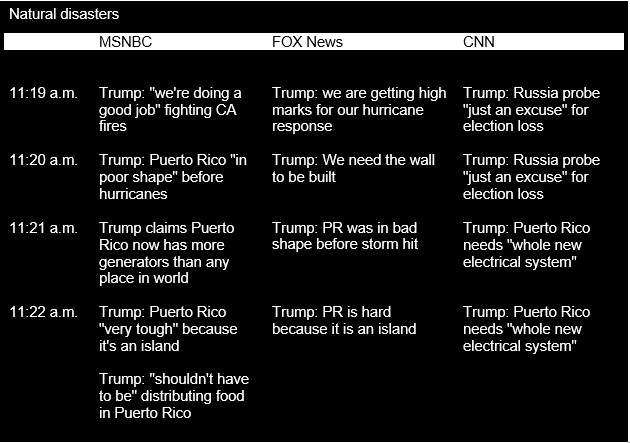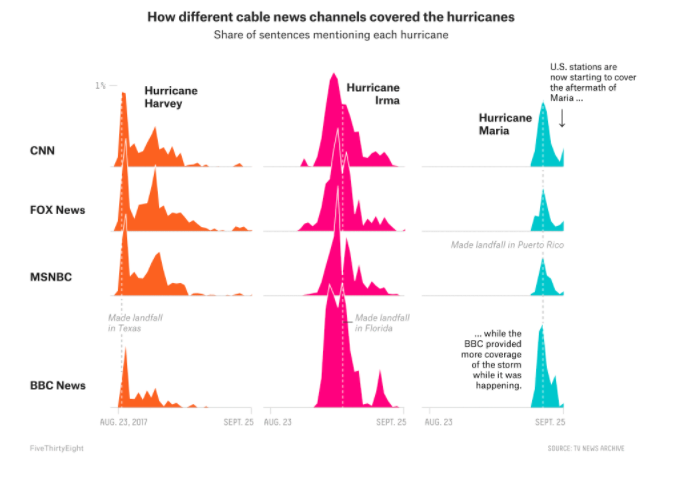A weekly round up on what’s happening and what we’re seeing at the TV News Archive by Katie Dahl and Nancy Watzman. Additional research by Robin Chin.
All three major U.S. cable news networks covered President Donald Trump’s impromptu press conference with Sen. Mitch McConnell, R., Ky., on Monday, October 16, but there were notable differences in their editorial choices for chyrons – the captions that appear in real-time on the bottom third of the screen – throughout the broadcast. We used the TV News Archive’s new Third Eye chryon extraction data tool to demonstrate these differences, similar to how The Washington Post examined FBI director James B. Comey’s hearing in June 2017.
The beauty of the Third Eye tool is you can do this too, any time there is breaking news or a widely covered live event, like yesterday’s Senate judiciary committee hearing where AG Jeff Sessions testified (7:31am-9:46am PT) or the October 5 White House briefing about Puerto Rico (11:20am-11:48am PT). Third Eye data – which includes chyrons from BBC News, CNN, Fox News, and MSNBC – is available for data download, via API, in both raw and filtered formats. (Get into the weeds over on the Third Eye collection page.) Please take Third Eye for a spin, and let us know if you have questions: tvnews@archive.org or @tvnewsarchive.
For example, at 11:03 PT, Trump began answering a question about pharmaceutical companies “making money.” MSNBC chooses a chyron that characterizes Trump’s statements as a claim, whereas Fox News displays Trump’s assertion that Obamacare is a disaster. CNN goes with a chyron saying that Trump is “very happy” to end Obamacare subsidies. In the following minute, 11:04, Fox News chooses other bold statements from Trump: “I do not need pharma money” and “I want tax reform this year.” CNN’s chyron instead says Trump “would like to see” tax reform, a less bold statement.
(Note: these are representative chryons from the minute period and did not necessarily display for the full 60-second period.)

Later in the press conference, the discussion turns to natural disasters before then focusing on the proposed wall on the border with Mexico. Again, Fox News features Trump making bold, simple assertions: “we are getting high marks for our hurricane response,” and “PR was in bad shape before the storm hit.” MSNBC instead uses the word “claims”: “Trump claims Puerto Rico now has more generators than any place in the world.”
 Watch the Trump-McConnell press conference in context on C-Span.
Watch the Trump-McConnell press conference in context on C-Span.
Fact-check: Sen. McCaskill not present for bill to weaken DEA (four Pinocchios)
The day following The Washington Post-60 Minutes report on legislation passed by Congress and signed by President Barack Obama to weaken the authority of the Drug Enforcement Agency, Sen. Claire McCaskill, D., Mo., called for repeal of the law. In an interview, she also said, “Now, I did not go along with this. I wasn’t here at the time. I was actually out getting breast cancer treatment. I don’t know that I would have objected. I like to believe I would have, but the bottom line is, once the DEA [Drug Enforcement Administration] kind of, the upper levels at the DEA obviously said it was okay, that’s what gave it the green light.”
But “despite her claim that she ‘wasn’t here at the time,’ McCaskill was clearly back at the Senate, participating in votes and hearings,” according to The Washington Post‘s Fact Checker’s Glenn Kessler. “McCaskill’s staff acknowledged the error, saying that they had forgotten she had come back at that time. ‘It was sloppy on our part, and we take responsibility,’ a spokesman said.”
Fact-check: Pressure from Trump led to stepped up NATO members’ defense spending (half true)
In an interview on October 15, Secretary of State Rex Tillerson said, “The president early on called upon NATO member countries to step up their contributions — step up their commitment to NATO, modernize their own forces… He’s been very clear, and as a result of that countries have stepped up contributions toward their own defense.”
PolitiFact reporter Allison Graves found that “25 NATO allies plan to increase spending in real terms in 2017.” And “according to NATO, over the last 3 years, European allies and Canada spent almost $46 billion more on defense, meaning increases in spending have occurred before Trump’s presidency. Experts said it’s possible that Trump’s pressure has contributed to the continuation of the upward trend, but Tillerson’s explanation glazes over the other factors that have led to increases, including the conflict in the Ukraine in 2014.”
Follow us @tvnewsarchive, and subscribe to our weekly newsletter here.




